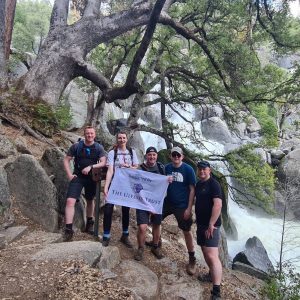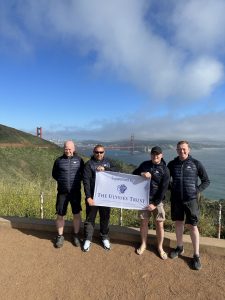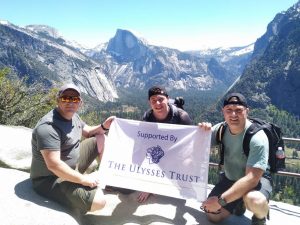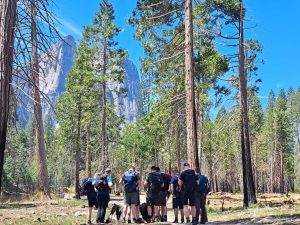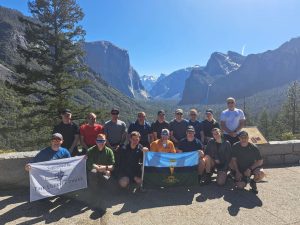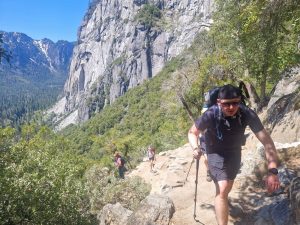Nestled within the grandeur of the Sierra Nevada mountains in California, the Yosemite National Park emerges as a captivating tapestry of awe-inspiring natural wonders. With its iconic granite cliffs, glacial valleys, thunderous waterfalls, and ecological diversity, the national park and its majestic Yosemite Valley offered the perfect setting for an expedition. In Mid-May a team made up of Regular and Reserve Officers and Soldiers from 32 Signal Regiment deployed, trekked, and explored the treasures of the region, conducting summer mountain activities in this challenging and beautiful environment.
Trekking in the footsteps of the great Scot, John Muir “Father of the National Parks”, (a pivotal figure in the conservation movement’s establishment and preservation of national parks in the USA), the expedition team deployed on 9 May 23. This presented an ideal window to experience the waterfalls at full force as the temperature across the park began to rise and melt the unprecedented amount of snow (230% above average) that lay in the glaciers and mountains that towered above. Residents and regular visitors of the region often initiated conversations with the team, opening with statements such as “the best waterfalls in 25 years” which became a comically repeated expression shared within the group.
In the deployment window, the expedition team completed 5 full days of trekking, covering 108km and a total climb of 3,862m. This was followed by a visit to the Mariposa Grove to explore the 3000-year-old Sequoia trees, and a day on the grade 3/4 white waters of the Merced River, using San Francisco as a commuting stop off on the outbound and inbound journeys from the UK. As a result of these activities, 6 members of the expedition achieved SMF competence, 2 x MLTs gained invaluable experience from the lead JSML, and other qualified SMF competent personnel managed to bag some quality overseas mountain days to add to their portfolios.
On arrival in California, the team travelled up from San Francisco to Wawona, a small settlement close to the entry of the national park and established a base utilising a furnished Redwood lodge; an ideal setting for facilitating the expedition needs, from training delivery to feeding and sleeping arrangements. An early evening brief, with Team 1 stepping up to cook the first meal of the expedition whilst the remainder settled into the accommodation, set the conditions for the days that lay ahead.
Trek 1 – The Yosemite Valley Loop
One thing that can be said about prior preparation and planning is the unpredictability of the weather within the Yosemite Valley, rising from minus 4 °C the week prior, to 20 °C upwards on day one. Trek 1 provided the ideal opportunity for the group to shake out, soak in the surrounding beauty of the towering cliffs and waterfalls and acclimatise to the heat and altitude of the National Park. The team orientated themselves to the ground, conducting a 20km low level trek across the valley floor, ticking off the big-ticket items such as El Capitan, Half Dome, and the Lower Yosemite Fall. The trek progressed through lush and flooded meadows, providing ample opportunity for all to take regular breaks to either capture the back drops like wild paparazzi at a red-carpet event or listen to talks on the geological makeup of the igneous plutonic granite rock formations and the glacial valley evolution over the millennia. The team experienced a sighting of an American Black Bear with her cubs in the low woodland meadow amongst blooming dogwood trees, many Mule Deer, a couple of Cayotes and a mocking vibrant blue Steller’s Jay. On return to the lodge, the team received further lessons and Team 2 upped the cooking game in preparation for Trek 2.
Trek 2 – The Yosemite Falls
On reflection, this walk presented the most challenging day for the group, with a steep ascent, and increasing temperatures, trekking from the valley floor to the summit of the Yosemite Falls. The expedition group analysed swiftly that to get the rewards of the summit view, some effort would be required to earn it; under the watchful eye of the JSML and MLTs, the team carefully paced up the steady ascent, experiencing changes of vegetation zones as they zig-zagged up the popular trail. As the group began to tower above the valley floor, frequent gaps in vegetation provided panoramic views, with Half Dome the prominent feature towering into the blue skies above. As the team neared the summit, patches of snow stubbornly fought against the beaming sun as tired legs circumnavigated on the granite plateau to a grand exposure of the entire valley, backed with the thundering noise of circa 7,000 gallons of water per-second hammering over the cliff edges of this glorious waterfall; a truly unforgettable and powerful experience. The journey back down felt less laboured than the journey up as the team reflected on what they had just seen, adjusting to issued trekking poles, and wondering where that bar at the top had gone. At the point shy of the trek finish, the team encountered another American Black Bear, this time a lot larger and with no cubs. One would assume this was a male bear who had enjoyed a healthy hibernation without the need to provide nutrition to growing cubs. With sore legs, a late, but well-made evening meal by Team 3 provided the fuel to tackle Trek 3.
Trek 3 – The Chilnualna Fall
A break from the 45-minute commute down to the valley floor, Trek 3 saw the expedition team depart on foot from the lodge in Wawona up to the summit of the Chilnualna Fall; a trek that provided opportunity for the JSML and MLTs to deliver lessons on first aid, navigation and kit packing. The team took the 20km route and ascended the falls through a remote woodland, passing grand oak and pine variations, whilst reading etched wooden signs marking a warning from mountain lions with questionable actions on. This trek is less well known to tourists and therefore, the expedition team had the trail to themselves to be fully immersed into their surroundings and relate to the early Indigenous inhabitants that walked the grounds for thousands of years before the gold rush in the 1850s catalysed the eventual force out of the Ahwahnechee people. The team paused for a lunch break at the top of the falls, experiencing some more breath-taking views beside rushing snow melt rivers that rolled over the waterfall cliffs as the instructors delivered lessons. On the descent, the team took a detour past the swinging bridge that crossed the rushing water below. Returning to the lodge at a more sociable hour, the team managed to enjoy a couple of cold drinks on the balcony whilst Team 4 stepped up to the plate.
Trek 4 – Mirror Lake
A trip back into the valley saw the team take on Mirror Lake; a slight recovery day following two days of waterfall ascents, they trekked along a segment of the East valley floor looping the heavily sedimented Mirror Lake, which reflected some fantastic rock faces from its surface. The 15km trail is typically marked as a pathed route for the most part and easily accessible; however due to the localised flooding and some treefall/landscape movement, this trek became remarkably entertaining, as the team waded through shallow waters, pushed through lush vegetation, and negotiated unforeseen obstacles. For lunch on this day, the JSML took the team through a practical session on rope and sling drills, utilising improvised and recommend methods to support groups in confidence roping and emergency scenarios. Sporadic rock fall remains were dotted throughout the walk and provided opportunity to deliver this lesson, take a few team pictures and, as they found out a little later, to conceal resting diamond back rattlesnakes. There were also plenty of salamanders and sun-soaked lizards on this trail. A great day, the team finished amongst the hustle of Curry Village. Team 1 was back on duty to provide a carb-load ready for the final trek.
Trek 5 – The Mist Trail and Half Dome
An early morning start to allow for the extended distance of circa 30km, the expedition group took on the mist trail with the addition of a Half Dome summit attempt. This Trek, despite all the grandeur in the days that proceeded, exceeded all expectations; it was truly phenomenal. The Mist Trail begins by following a marked trail between Grizzle Peak and Liberty Cap, first passing through Vernal Falls. As the team first approached the falls, roughly 300m out, the spray began to intensify with many a walker stopping short to extract waterproof clothing in preparation for the crossing. Much of the group paid lip service to this warning order and pushed through this immense theme-park-water-ride of a fall on its south side until rising above it, looking back in sodden clothing, and taking in the view of the rainbow amongst the mist of the valley backdrop. A quick shake off and the team carried on with the ascent, avoiding at this stage the loop back through Nevada Falls and pushing up to Half Dome. Very quickly the vegetation changed and as they proceeded through “little Yosemite Valley” the ground opened out into a very dry,
Mediterranean landscape to the East of Liberty Cap. After a few Kilometers, the ground began to ascend and the vegetation changed once again, as the team began an ascent through a montane region toward Half Dome. Littered with Pine, Oak, incense-Cedar, and red fir trees, this was bear land. Cautiously ascending, the team managed to make it to the foot of Half Dome before encroaching on heavy snow at the base of the final section. The assessment was made that if the team were to go any further, they would be beyond remit and the right decision was made to descend back onto the mist trail loop. On re-joining the mist trail, the team continued towards Nevada Falls which provided little mist, though a heavy shower to give all a Wim Hoff full body experience in the ice-cold flush that precipitated from above. A group favourite: on completion, a well-deserved pizza and beer was enjoyed by all.
Note: A lesson for anyone planning a Yosemite expedition in the attempt to tackle the summit of Half Dome; consider arriving in early June to avoid the snow and hope the ballot tickets come through.
White Water and Mariposa Grove
On conclusion of the trekking activities, the team were fortunate to experience some white-water rafting on the grade 3 / 4 Merced River. A 16km, 2-hour adventure saw the team break down into 3 rafts, working as teams to negotiate the rapids of the Californian snow melt river. Great moral courage was shown by some members of the team that stepped outside of their comfort zone to conduct this activity; for all it was a thrilling exercise, with a few swimmers in the water for the team to reflect and laugh about when reviewing the video footage.
Following the white-water trip, the team took time to hike around the Mariposa Grove 10km trail, taking in the 3,000-year-old Sequoia Trees; the largest living organisms on the planet boasting towering, girthy trunks that are fantasy-like. The grove hosts the infamous Tunnel Tree and Grizzly Giant Sequoias that were first measured and counted by Galen Clark in 1857. Known as the first guardian of the park, Mr Clark wrote about these trees and the surrounding grove which eventually influenced US Congress and President Abraham Lincoln to grant Yosemite as a protected park, signing the Yosemite Land Grant in 1864. This movement led to the collaborative efforts of the conservation group and John Muir to achieve National Park status by 1890.
On completion of the activities, the team returned via San Francisco, crossing the Golden Gate Bridge (some by impromptu half marathon), and undertaking an audio tour of Alcatraz prior to returning home to the UK.
Internally, a huge thanks and particular praise goes to SSgt Matthew Campbell, the lead coordinator and an MLT for the expedition, and our experienced JSML, Capt Jim McGrory, OIC of the deployment. An event extremely well planned and delivered, both were supported by 2 x support staff who provided all the RLS support, from driving to facilitation: WO2s Gordon Heaney and Mark Howells, a job extremely well done, for which the team were incredibly grateful.
Externally, the trip would not have been possible without the generous support and contributions of several organisations affiliated to 32 Signal Regiment. These organisations are: The Army Sports Lottery; The Army Mountaineering Association; Highland RFCA; Northern Ireland RFCA; HQ R SIGNALS; the Berlin Infantry Brigade Memorial Trust; and the Ulysses Trust – Thank you.
SSgt Matthew Campbell

